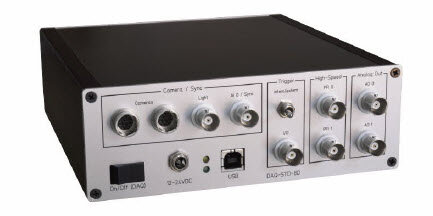Unlocking Insights: The Power of Data Acquisition Systems
Unlocking Insights: The Power of Data Acquisition Systems
Blog Article

In today's data-driven world, the ability to collect and analyze information is more crucial than ever. Organizations across various industries are recognizing the importance of harnessing data to drive decisions, improve efficiency, and foster innovation. At the heart of this transformation lies the Data Acquisition System, a powerful tool that allows for the systematic collection, measurement, and analysis of data from various sources.
Data Acquisition Systems serve as the backbone for a multitude of applications, ranging from scientific research to industrial processes. By capturing data in real-time, these systems enable businesses and researchers to gain insights that were previously difficult to obtain. As we delve deeper into the world of data acquisition, we will explore how these systems function, their key components, and the significant impact they have on decision-making and operational success.
Understanding Data Acquisition Systems
Data Acquisition Systems, often abbreviated as DAS, are essential tools used to collect, measure, and analyze data from various sources. These systems convert real-world phenomena such as temperature, pressure, and sound into digital signals that can be processed and stored. By doing so, they enable engineers, scientists, and researchers to monitor conditions and perform detailed analyses, making them invaluable across numerous industries, from manufacturing to environmental monitoring.
The core components of a Data Acquisition System typically include sensors, signal conditioning equipment, data converters, and data processing units. Sensors gather raw data from the environment, which is then refined by signal conditioning units to eliminate noise and ensure accuracy. Once the data is conditioned, it is converted into a digital format using analog-to-digital converters, allowing for further analysis and interpretation. This systematic approach to data gathering ensures that stakeholders have access to precise and actionable information.
In recent years, advancements in technology have significantly enhanced the capabilities of Data Acquisition Systems. The integration of wireless technologies, cloud computing, and sophisticated software solutions has made it easier to collect and analyze data in real time. These improvements not only increase efficiency but also provide users with greater flexibility in how they monitor and respond to changes in their systems. As organizations continue to realize the importance of data-driven decision-making, the role of Data Acquisition Systems becomes increasingly vital.
Key Components and Technologies
A Data Acquisition System is comprised of several crucial components that work in synergy to gather, process, and analyze data. The primary elements include sensors, data converters, and a processing unit. Sensors are responsible for capturing physical phenomena such as temperature, pressure, or light. These sensors convert the analog signals from the environment into a format suitable for further processing. Data converters, often in the form of Analog-to-Digital Converters, transform the analog signals into digital form, allowing for easier manipulation and analysis by computers.
The processing unit is the brain of the Data Acquisition System. This component can range from simple microcontrollers to powerful computers that run sophisticated software. It is responsible for managing data flow, executing algorithms for data analysis, and facilitating communication with other systems or networks. Additionally, the software ecosystem is vital, as it includes applications for data visualization, storage, and real-time monitoring. This software allows users to interpret the collected data effectively and gain insights that would otherwise remain hidden in raw numbers.
Networking and connectivity technologies also play an essential role in modern Data Acquisition Systems. With advancements in wireless communication and Internet of Things (IoT) technologies, data can now be acquired, transmitted, and analyzed remotely. This capability allows for real-time data access, making it possible to monitor systems from anywhere in the world. As organizations increasingly demand timely information to drive decision-making, the integration of advanced networking components ensures that Data Acquisition Systems remain relevant and powerful tools for insight generation.
Data Acquisition System
Applications and Benefits
Data Acquisition Systems play a crucial role across various industries by providing real-time data collection and monitoring. In the manufacturing sector, these systems enhance process control by capturing operational data. This allows for timely adjustments and optimizations, leading to increased efficiency and reduced downtime. The ability to monitor equipment performance and environmental conditions contributes significantly to maintaining quality standards and ensuring safety protocols are followed.
In the field of research, Data Acquisition Systems are indispensable for gathering data in experiments and studies. They facilitate precise measurements in laboratories, enabling scientists and researchers to analyze trends and derive meaningful conclusions. This capability is particularly valuable in fields like environmental science, physics, and engineering, where accurate data is essential for advancing knowledge and innovation. By automating data collection, these systems free up researchers to focus on analysis rather than manual data logging.
Moreover, Data Acquisition Systems also benefit the healthcare industry by enabling patient monitoring and diagnostics. With the integration of sensors and devices, healthcare providers can continuously track vital signs and other health parameters. This real-time data acquisition leads to quicker decision-making and improved patient care. As technology evolves, the application of these systems will continue to expand, further enhancing their impact in diverse areas such as smart cities, transportation, and utilities management.
Report this page